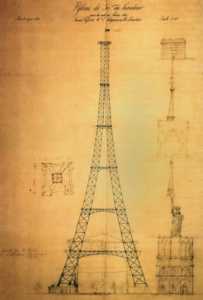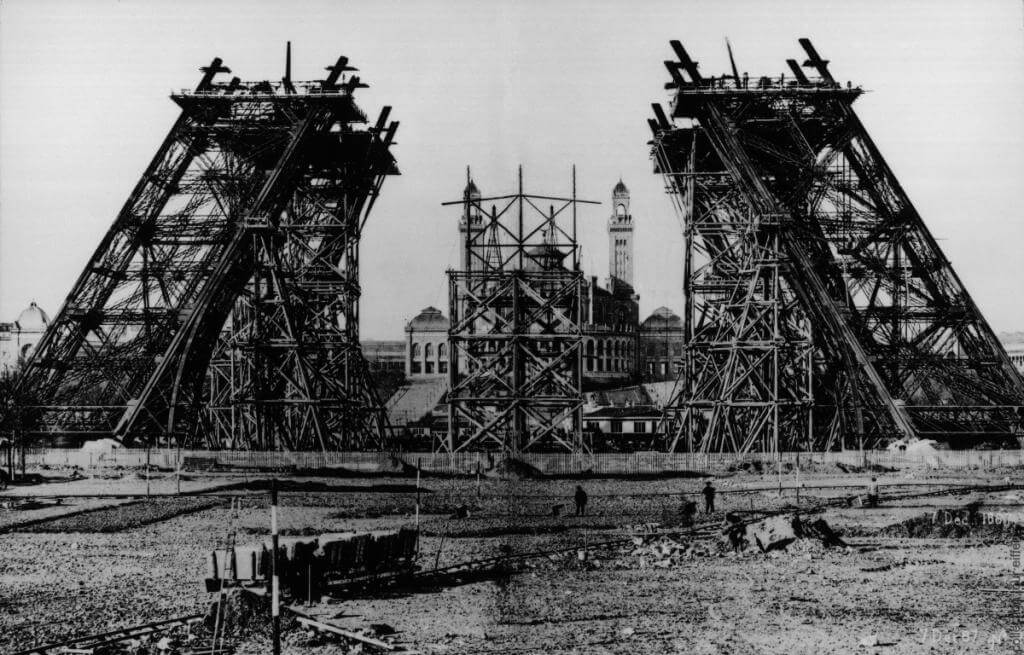When you think of France, chances are a few images immediately come to mind: baguettes, red wine, mimes, wheels of cheese. But one visual towers, literally and figuratively, above them all – the Eiffel Tower.
Built on Paris’s Champs de Mars in the late 19th century, it was a daring project that would alter the city’s skyline and become a global symbol of architectural innovation. Arguably one of the most universally recognizable structures on earth, it not only showcased the ingenuity of its creators but also demonstrated construction (and safety) techniques ahead of their time. Let’s dive into the quirky and fascinating world of how the Eiffel Tower was built.
The Dream, the Planning, and the Design

The story begins with Gustave Eiffel, an engineer whose appetite for innovative design was as towering as the structure he would eventually create. When Eiffel proposed his iron tower for the 1889 Exposition Universelle, critics scoffed, calling it an eyesore and a ‘metal asparagus‘. Despite this absolutely scathing burn, Eiffel believed in his vision of demonstrating the potential of iron as a building material.
Over 18,000 iron parts were made in Eiffel’s factory on the outskirts of Paris, each piece painstakingly measured and designed to fit together perfectly. It took about 40 engineers and draftsmen to create the 3,600 detailed drawings for the iron fabrication. The assembly was like completing a giant jigsaw puzzle, but with the added challenge of ensuring it could withstand wind forces and the weight of the structure itself. Each of the 18,000 pieces were precisely designed and subsequently machined to an accuracy of a tenth of a millimeter and pre-assembled in a factory.
The building process was riveting, quite literally (listen, the French love a pun, so just let this one go). The tower was held together by over 2.5 million rivets, a process that required great skill and teamwork. Teams of four worked in unison: one worker to heat the rivet, another to hold it in place, a third to shape the head, and a fourth to hammer it home. This symphony of labour was not only a testament to the workers’ craftsmanship but also a key to the tower’s enduring strength.
The Eiffel Tower Construction Timeline
- 26th January 26, 1887 — Workers break ground for the foundations
- July 1, 1887 — The four pillars are started
- April 1, 1888 — First floor completed
- August 14, 1888 — Second floor completed
- March 31, 1889 — Construction completed
Specialized Tools and Processes
- Steam cranes (aka “creepers”), mounted onto the inside of the pillars and able to climb as the tower was constructed.
- Temporary wooden scaffolding, up to 45 meters in height.
- “Sand boxes” were used to align the four first-floor girders to within one millimeter.
- Hydraulic jacks at the base of the structure, operated by hand pump, which were replaced by permanent steel wedges.
- 16 watertight, pneumatic metal caissons and compressed air were used so the builders could work below the water level on the Seine side to create the foundations.
Groundbreaking Safety Measures
Building such a monumental structure in the 1880s posed significant safety challenges, yet the project was remarkably forward-thinking in its approach to worker safety. Given the height and complexity of the tower, the potential for accidents was high. Eiffel instituted several safety measures that were revolutionary for the era. For instance, he mandated the use of safety nets and guardrails around the construction site to protect workers from falls. Additionally, all workers were required to use safety harnesses while working at heights, a practice not commonly enforced at the time.
Eiffel also recognized the importance of the workers’ general well-being. He set up an on-site medical clinic to provide immediate care for any accidents or health issues, reducing the time to treat injuries and improving recovery outcomes. Regular breaks and the provision of meals ensured that the workers were well-rested and nourished, helping to maintain their physical strength and focus, which were critical for safety on such a demanding project.

Eiffel Tower Construction Deaths
Despite these precautions, the construction of the Eiffel Tower was not without its risks. Remarkably, given the era and the scale of the project, there was only one fatality during the construction of the tower. This tragedy occurred not due to structural failure or a fall, but because a worker disobeyed safety instructions, leaving the construction site during the workday to visit the nearby neighborhood, where he met his unfortunate fate.
This low number of fatalities, especially in an age when construction safety was often an afterthought, is a testament to the stringent safety measures Eiffel put in place and his commitment to the well-being of his workers. It is said that Eiffel even paid the workers an above-average rate compared to other work sites. It stands in stark contrast to other monumental constructions of the era, where worker fatalities were sadly more common.
The construction of the Eiffel Tower set a precedent for safety in construction projects, highlighting the importance of proactive safety measures and worker welfare. Eiffel’s approach to safety during the tower’s construction played a crucial role in its success and left a lasting legacy in the field of engineering and construction safety standards.
A Symbol of Ingenuity and Construction Safety
More than a century later, the Eiffel Tower stands as a testament to the bold vision and innovative engineering of its creators. Its construction techniques, particularly the use of prefabricated iron parts and modular design, laid the groundwork for modern skyscrapers and architectural feats.
The Eiffel Tower, once deemed an iron monster, is now beloved as a symbol of Parisian elegance and ingenuity. Its story is a vibrant chapter in the history of construction, reminding us that with creativity, collaboration, and a bit of daring, even the wildest dreams can be built to stand the test of time.
In the end, the Eiffel Tower stands not only as a monument to architectural and engineering brilliance but also as a beacon of progress in construction safety and worker protection. The tower’s legacy is built on the foundation of human endeavor and the unwavering commitment to ensuring that such endeavors do not come at the cost of human lives.
Through the lens of safety, the story of the Eiffel Tower becomes even more impressive, reminding us that the greatest achievements in construction are not just about the structures we build but also about advancing the care and safety of the people who build them.
Eiffel Tower Facts
Just in case the Eiffel Tower is ever a category at pub trivia, here are some genuinely interesting facts about it:
- How tall is the Eiffel Tower? It is 300 meters (984 feet) high.
- Why was the Eiffel Tower built? It was built as a main attraction for the 1889 Exposition Universelle, which was a celebration of the 100th anniversary of the French Revolution.
- How long did it take to build? It took 2 years, 2 months, and 5 days to build the Eiffel Tower. The construction timeline was incredibly tight, but despite the daunting schedule, the construction team, often working in harsh conditions, completed the tower in record time, with the final rivet being driven on March 31, 1889. The project’s success was a testament to Eiffel’s meticulous planning and the tireless work of his team.
- Did the Eiffel Tower have an elevator when it was built? Yes! In 1889, they were some of the most unique and sophisticated elevators in the world. Getting visitors to the top was one of the most fascinating aspects of the construction because traditional elevator designs were not feasible for the tower’s unique curvature. Eiffel, in a stroke of brilliance, collaborated with the American company Otis to design a bespoke hydraulic elevator. It was a marvel of engineering that delighted visitors with its smooth ascent along the tower’s legs, offering breathtaking views of Paris.
- How many stairs does the Eiffel Tower have? There are 1,665 steps from the ground to the top, but only 674 steps are accessible to the public.
- How much does the Eiffel Tower weigh? It weighs 10,100 tons.
- How many workers did it take to build the Eiffel Tower? Sources say 150-300 workers were employed during the construction of the tower.
- Was it meant to be a temporary attraction for the World Exhibition? The Eiffel Tower was originally intended to be dismantled after 20 years. It was only saved because it proved valuable as a radiotelegraph station.
- What colour is the Eiffel Tower? The Eiffel Tower gets a fresh coat of paint every seven years, requiring about 60 tons of paint. Interestingly, it has changed color several times, from reddish-brown to yellow-ochre, and now to the current “Eiffel Tower Brown.”
- Does the tower move? On sunny days, the iron structure can expand and contract, causing the tower to sway up to 15 centimeters (6 inches) in the wind and heat.
- Was there a secret apartment at the top of the tower? Gustave Eiffel had a private apartment at the top of the tower, where he entertained famous guests like Thomas Edison. Today, visitors can peek into this apartment, now a museum display.
- Why does it sparkle? The Eiffel Tower’s sparkling light show was initially a temporary installation for the Millennium Celebration in 2000. Due to its popularity, it became a permanent feature.
- How long was it the tallest structure? The Eiffel Tower was the world’s tallest man-made structure for 41 years until the completion of the Chrysler Building in New York in 1930.
- Are there any fun Eiffel Tower “easter eggs”? Engraved on the sides of the Eiffel Tower are the names of 72 French scientists, engineers, and mathematicians in recognition of their contributions, acting as a monumental “thank you” note.
- Did Hitler climb the Eiffel Tower? During World War II, the French famously cut the lift cables on the Eiffel Tower to prevent Hitler from visiting the top unless he climbed the stairs. He never did..
- What else is the Eiffel Tower used for? The tower has been used for various scientific purposes, including meteorology, astronomy, and physics experiments. It even served as a wind tunnel for aerodynamic testing.
- How many replicas exist? The Eiffel Tower has inspired over 30 replicas and similar structures around the world, from Las Vegas to Tokyo, showcasing its iconic status in global culture.
- Did the Eiffel Tower catch on fire in 2024? No, it was a computer-generated clip of the tower on fire that went viral with eight-million views before people realized it was fake.
Sources:
TOUREIFFEL.PARIS
Iron Lady: The Eiffel Tower, Civil Engineering, December 2014
Eiffel Tower: Construction Features of the Iron Giant
3D Modelling of Eiffel Tower Using Original Drawings (Masters Thesis)
Origins and Construction of the Eiffel Tower
The Construction of the Eiffel Tower
Secrets of the Eiffel Tower, Yale Scientific
Construction of the Eiffel Tower, Wonders of the World
Great Project Managers – Gustave Eiffel, The.Project.Management.Hut
Barthes, Roland. The Eiffel Tower, and other mythologies. New York: Hill and Wang, 1979. ISBN 978-0809041152